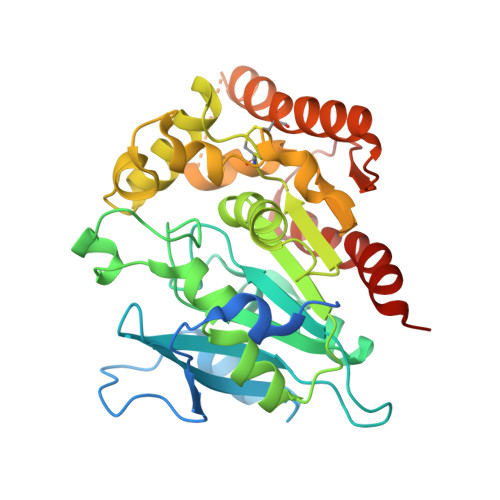Identification of a mycoloyl transferase selectively involved in o-acylation of polypeptides in corynebacteriales.
Huc, E., de Sousa-D'Auria, C., de la Sierra-Gallay, I.L., Salmeron, C., van Tilbeurgh, H., Bayan, N., Houssin, C., Daffe, M., Tropis, M.(2013) J Bacteriol 195: 4121-4128
- PubMed: 23852866
- DOI: https://doi.org/10.1128/JB.00285-13
- Primary Citation of Related Structures:
4H18 - PubMed Abstract:
We have previously described the posttranslational modification of pore-forming small proteins of Corynebacterium by mycolic acid, a very-long-chain α-alkyl and β-hydroxy fatty acid. Using a combination of chemical analyses and mass spectrometry, we identified the mycoloyl transferase (Myt) that catalyzes the transfer of the fatty acid residue to yield O-acylated polypeptides. Inactivation of corynomycoloyl transferase C (cg0413 [Corynebacterium glutamicum mytC {CgmytC}]), one of the six Cgmyt genes of C. glutamicum, specifically abolished the O-modification of the pore-forming proteins PorA and PorH, which is critical for their biological activity. Expectedly, complementation of the cg0413 mutant with either the wild-type gene or its orthologues from Corynebacterium diphtheriae and Rhodococcus, but not Nocardia, fully restored the O-acylation of the porins. Consistently, the three-dimensional structure of CgMytC showed the presence of a unique loop that is absent from enzymes that transfer mycoloyl residues onto both trehalose and the cell wall arabinogalactan. These data suggest the implication of this structure in the enzyme specificity for protein instead of carbohydrate.
Organizational Affiliation:
Team Enveloppes Mycobactériennes, Structure Biosynthèse et Rôles, Centre National de la Recherche Scientifique (CNRS), Institut de Pharmacologie et Biologie Structurale (IPBS), Département Mécanismes Moléculaires des Infections Mycobactériennes, UMR 5089, Toulouse, France.















